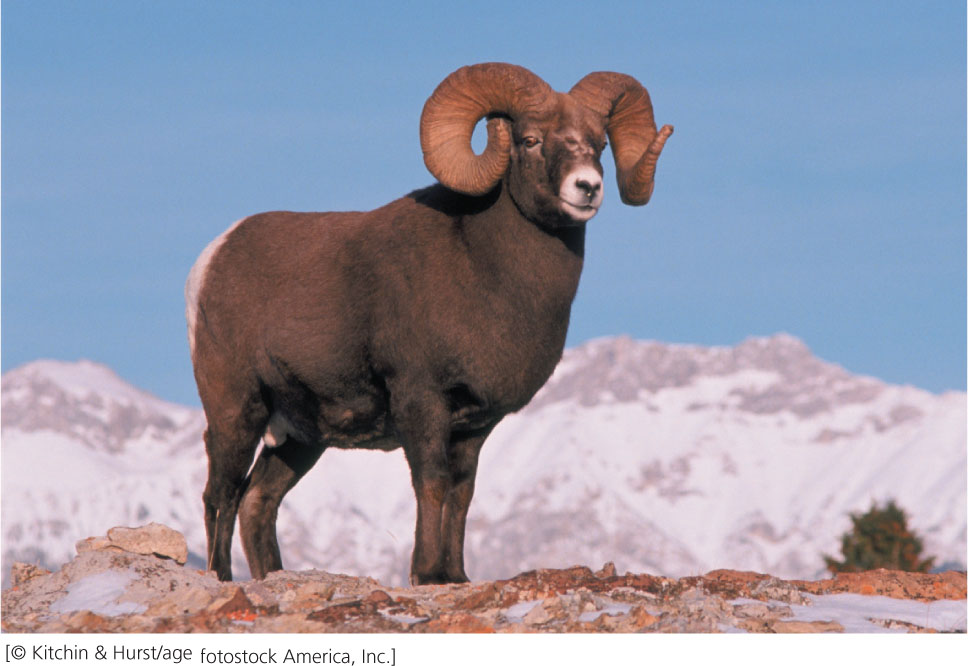Genetic Rescue of Bighorn Sheep
Rocky Mountain bighorn sheep (Ovis canadensis) are among North America’s most-spectacular animals, characterized by the male’s magnificent horns that curve gracefully back over the ears, spiraling down and back up beside the face. Two hundred years ago, bighorn sheep were numerous throughout western North America, ranging from Mexico to southern Alberta and from Colorado to California. Meriwether Lewis and William Clark reported numerous sightings of these beautiful animals in their expedition across the western United States from 1804 to 1806. Before 1900, there were about 2 million bighorn sheep in North America.

Unfortunately, settlement of the west by Europeans was not kind to the bighorns. Beginning in the late 1800s, hunting, loss of habitat, competition from livestock, and diseases carried by domestic sheep decimated the bighorns. Today, fewer than 70,000 bighorn sheep remain, scattered across North America in fragmented and isolated populations.
In 1922, wildlife biologists established a population of bighorn sheep at the National Bison Range, an isolated tract of 18,000 acres nestled between the mountains of northwestern Montana. In that year, 12 bighorn sheep—four males (rams) and eight females (ewes)—were trapped at Banff National Park in Canada and transported to the National Bison Range. No additional animals were introduced to this population for the next 60 years.
At first, the population of bighorns at the National Bison Range flourished, protected from hunting and livestock. Within 8 years, the population had grown to 90 sheep but then began to slowly decrease in size. Population size waxed and waned through the years, but the number of sheep had dropped to about 50 by 1985, and the population was in trouble. The amount of genetic variation was low compared with other native populations of bighorn sheep. The reproductive rate of both male and female sheep had dropped, and the size and survival of the sheep were lower than in healthier populations. The population at the National Bison Range was suffering from genetic drift, an evolutionary force operating in small populations that causes random changes in the gene pool and the loss of genetic variation.
To counteract the negative effects of genetic drift, biologists added five new rams from other herds in Montana and Wyoming in 1985, mimicking the effects of natural migration among herds. Another 10 sheep were introduced between 1990 and 1994. This influx of new genes had a dramatic effect on the genetic health of the population. Genetic variation among individual sheep increased significantly. Outbred rams (those containing the new genes) were more dominant, more likely to copulate, and more likely to produce offspring. Outbred ewes had more than twice the annual reproductive success of inbred females. Adult survival increased after the introduction of new genes, and, slowly, the population grew in size, reaching 69 sheep by 2003.
The bighorn sheep at the National Bison Range illustrate an important principle of genetics: small populations lose genetic variation with the passage of time through genetic drift, often with catastrophic consequences for survival and reproduction. The introduction of new genetic variation into an inbred population, called genetic rescue, often dramatically improves the health of the population and can better ensure its long-term survival. These effects have important implications for wildlife management, as well as for how organisms evolve in the natural world.
This chapter introduces population genetics, the branch of genetics that studies the genetic makeup of groups of individuals and how a group’s genetic composition changes with time. Population geneticists usually focus their attention on a Mendelian population, which is a group of interbreeding, sexually reproducing individuals that have a common set of genes—the gene pool. A population evolves through changes in its gene pool; therefore, population genetics is also the study of evolution. Population geneticists study the variation in alleles within and between groups and the evolutionary forces responsible for shaping the patterns of genetic variation found in nature. In this chapter, we will learn how the gene pool of a population is measured and what factors are responsible for shaping it.